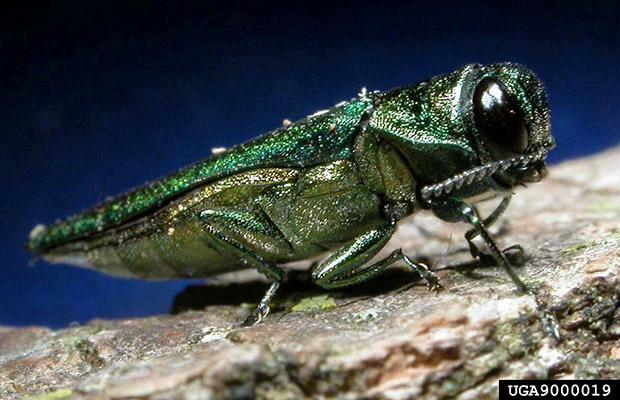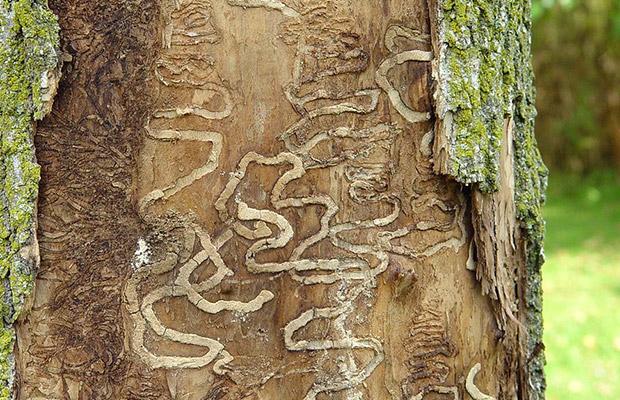Threat
Damage may occur through defoliation of the trees and from damage to the bark and underlying tissues from the burrowing activity of the larvae.

Susceptible species
Primarily Fraxinus but also Juglans, Ulmus and Pterocarya in forests, urban plantings and ornamental trees.
Spread
EAB can spread naturally from the movement of adult beetles. It is a strong flyer and is capable of making flights longer than 1km (Haack et al., 2002). In a quarantine area in the USA, scientists have recorded flight distances of 0.3-19.3km, with a maximal dispersal distance of 1.4km. It was observed that an 800m ash-free zone did not prevent spread, because adult beetles were capable of flying further to locate host trees.
Long distance movement in trade may occur. A. planipennis may be hidden in wood and wood products (including wood, wood packaging material, wood chips, firewood) containing bark strips and plants (including bonsai and cuttings).
In decreasing order of risk, main pathways for A. planipennis may be:
- packaging wood material
- untreated wood
- plants for planting (including bonsai)
Outbreak stage and national plans
There is no current UK outbreak but a contingency plan is in place to guide a national response should the pest be introduced.
Distribution
The emerald ash borer is native to the north-east China, Korea, Mongolia, Japan and the Russian Far East., Currently it is officially absent from the European Union (EU) and the UK.
The emerald ash borer has been introduced into North America and the Moscow region of the European part of Russia.
It was accidentally introduced into North America, probably in the 1990s, and most likely in imported wooden packing material. It is currently absent in the EU but is known to be present in the Russian states bordering the Ukraine.
Should it move into the Baltic States from Russia the risk of accidental introduction could increase significantly.
Symptoms
Infestation of large trees normally starts in the canopy. However, infestation progresses down the tree and in the later stages of infestation, the base of the tree and surface roots can be infested. Infestation tends to start at a place where diameter is 5-10 cm (T Scarr, personal communication).

A. planipennis generally has one generation per year, although some individuals may require two years.
Key characteristics of the pest:
- d-shaped exit holes produced by emerging adults
- larval galleries, which are typical for the genus Agrilus
- symptoms of infested trees: yellowing then premature browning of the foliage, thinning of crowns, dying of branches, longitudinal bark splits with larval galleries underneath, epicormic branches and shoots often along the lower trunk, dead branches
- secondary bird damage is commonly observed in North America and European Russia on infested trees. Birds remove small patches of bark or create small holes in the bark to extract developing A. planipennis. On heavily infested trees, woodpeckers in search of A. planipennis can flake off large areas of outer bark, which can accumulate at the base of the tree. This also leaves the trunk with large areas of light brown or whitish bark
Reporting suspect cases
If you think you have spotted the disease, please check our symptoms section before reporting it using TreeCheck or one of the Further Information contact points below.
Management, grants, treatment
See Pest Risk Assessment
The science
See Pest Risk Assessment
Origins
No current outbreak
Pest risk analysis
Import & movement restrictions
The EU has placed import restrictions on wood of ash (including firewood) from regions where EAB is present (North America, Russia, China, Japan, Mongolia, North Korea, South Korea), but not for any movement within the EU.
Further information
Questions and answers
Contact:
Plant Health Inspection Branch
DAERA Northern Ireland
Tel: 0300 200 7847
Email: planthealth@daera-ni.gov.uk
